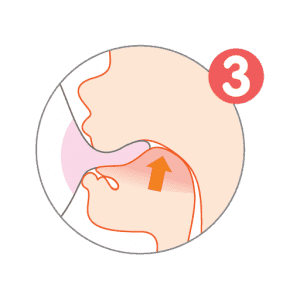A baby is born with the ability to drink milk in a completely different way to that of an adult. First, a baby tightly attaches his lips and tongue onto the nipple (‘attachment’). He then begins moving his tongue in a wave-like way of motion called ‘Peristaltic tongue movement.’ This motion compresses the areola and breast to extract the milk (‘sucking’). Finally the back of the tongue rises, channeling the milk into the esophagus (‘swallowing’). These three key steps work together to enable a baby to to suck milk smoothly and efficiently.

Attachment (Latch on)
The lips open outward and latch on to the areola.
Sucking fossa – small round cavity in the center of the upper jaw found only in babies

Peristaltic tongue movement (sucking)
Wave-like tongue movement squeezes the nipple and extracts milk.

Swallowing
The back of the tongue rises, channeling the milk into the esophagus.
We’ve created a guide to breastfeeding to prepare you of what’s to come and build your confidence in conquering this!
You can read the full guide here: PIGEON_Breastfeeding Guide
Help your baby latch on properly to take full advantage of this peristaltic movement, which the baby is born with.
TIP 1:
Position the baby so his nose is facing the nipple. This is best achieved if baby and mom are stomach to stomach. The baby's lower jaw should be touching the bottom of the areola.
TIP 2:
Touch the baby's lips with the nipple or areola to stimulate the rooting reflex. Wait until baby opens the mouth, and move the baby closer to the breast.
TIP 3:
The part of the areola next to the baby's lower jaw enters the baby's mouth first. Check to see if the baby has firmly latched on to the breast.
TIP 4:
Your baby will usually unlatch when he or she is finished feeding, but sometimes stays on but not actively sucking. If this happens, slide your finger gently into the side of the baby's mouth to break the seal.









